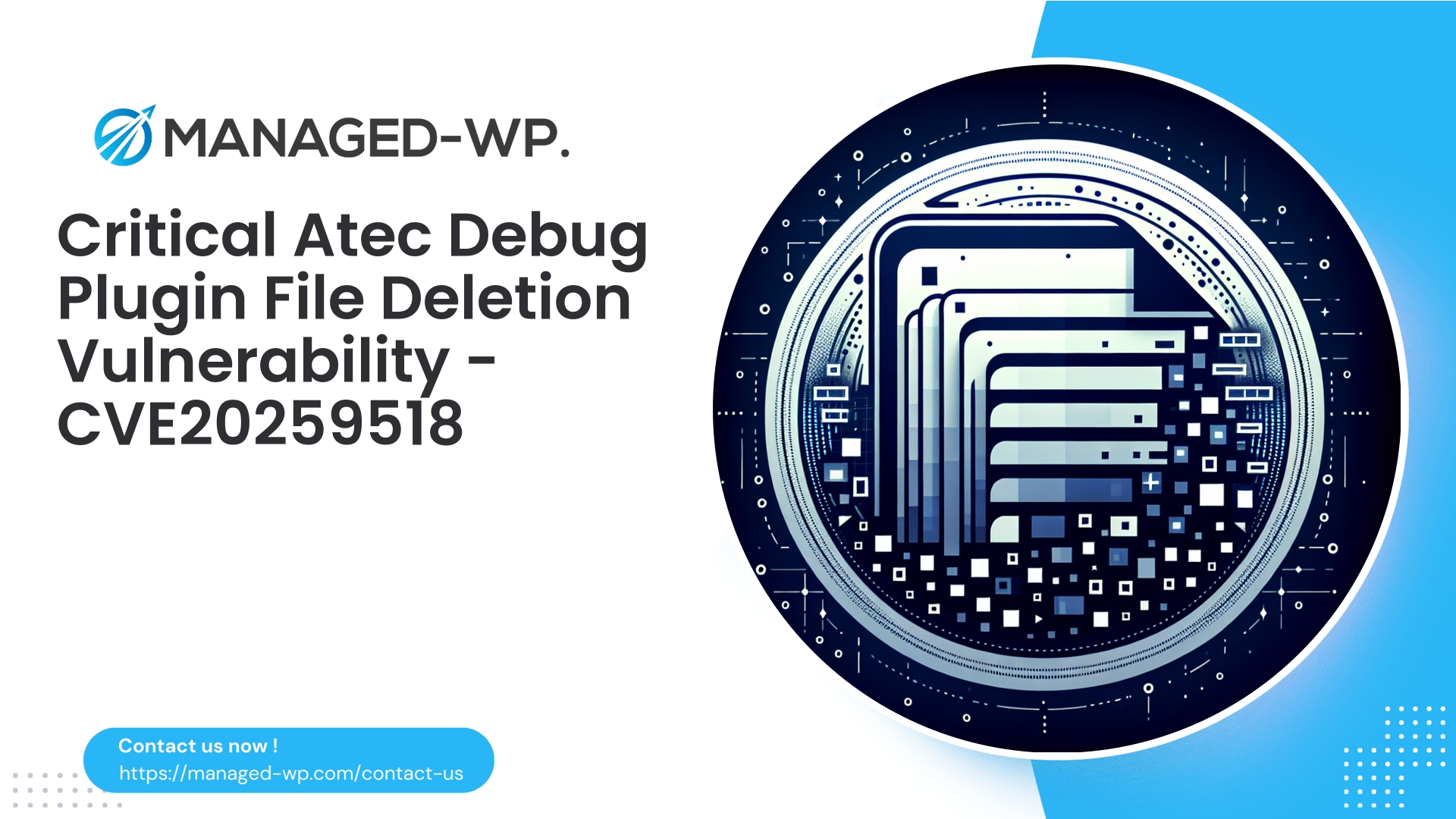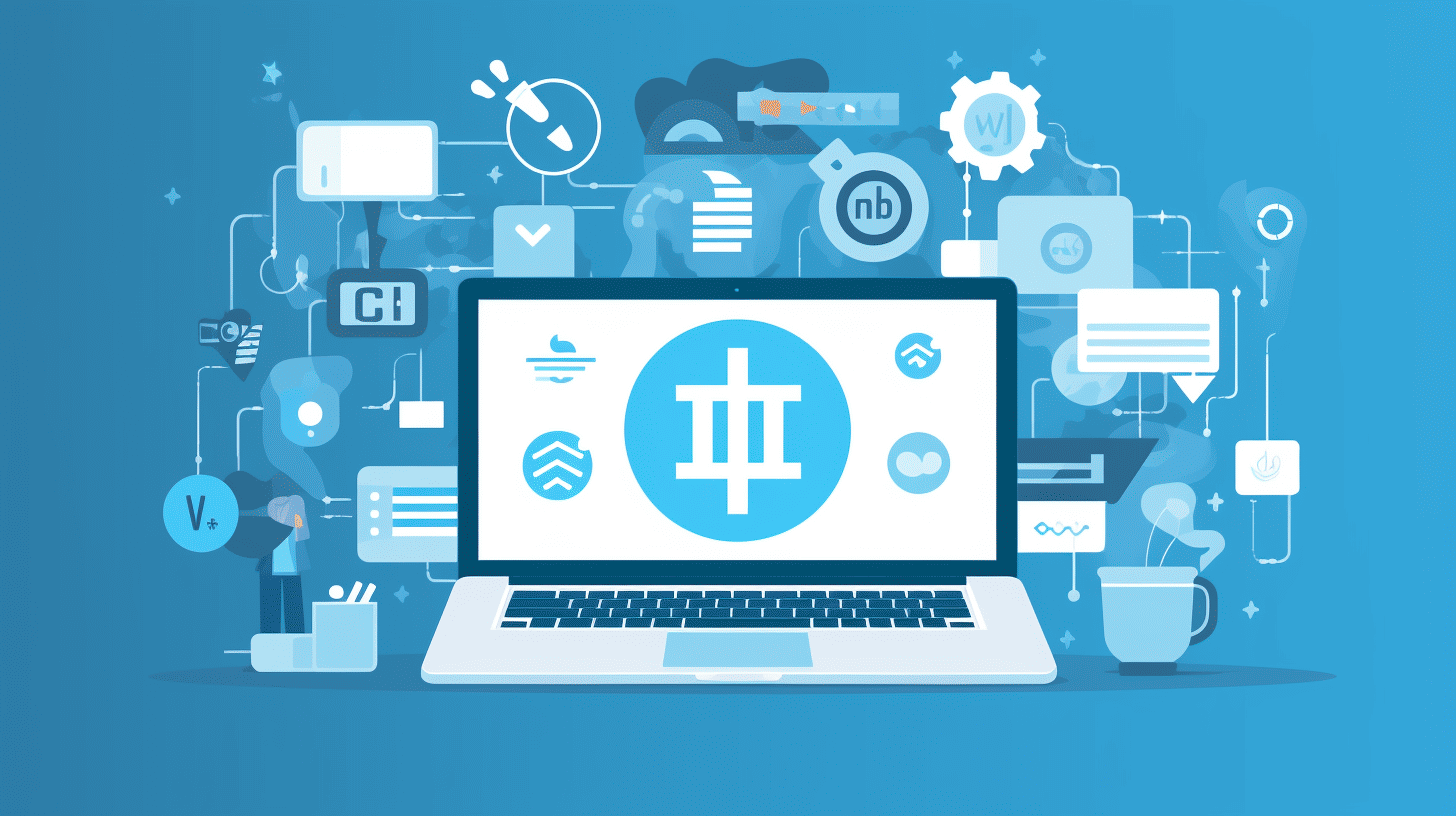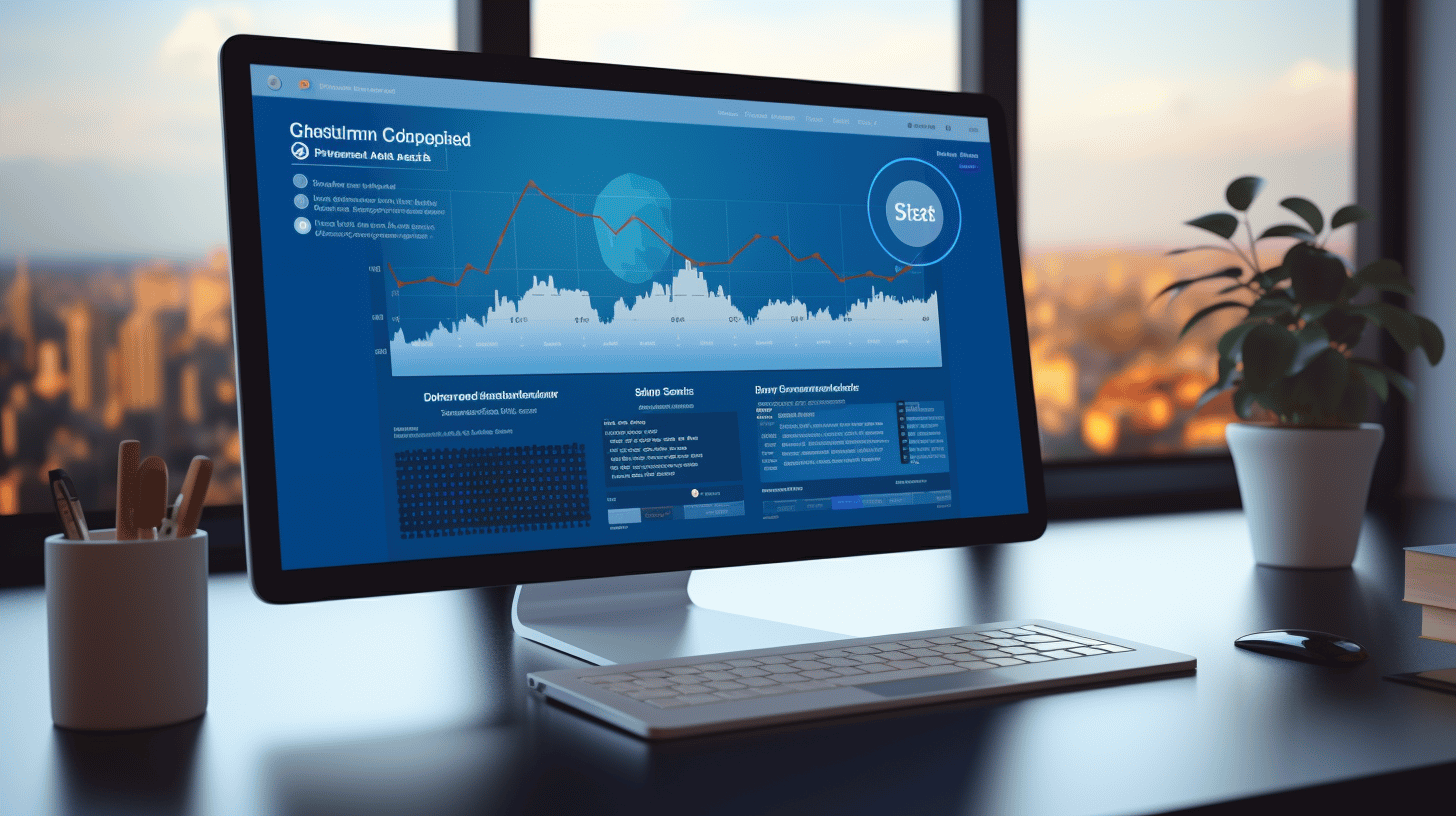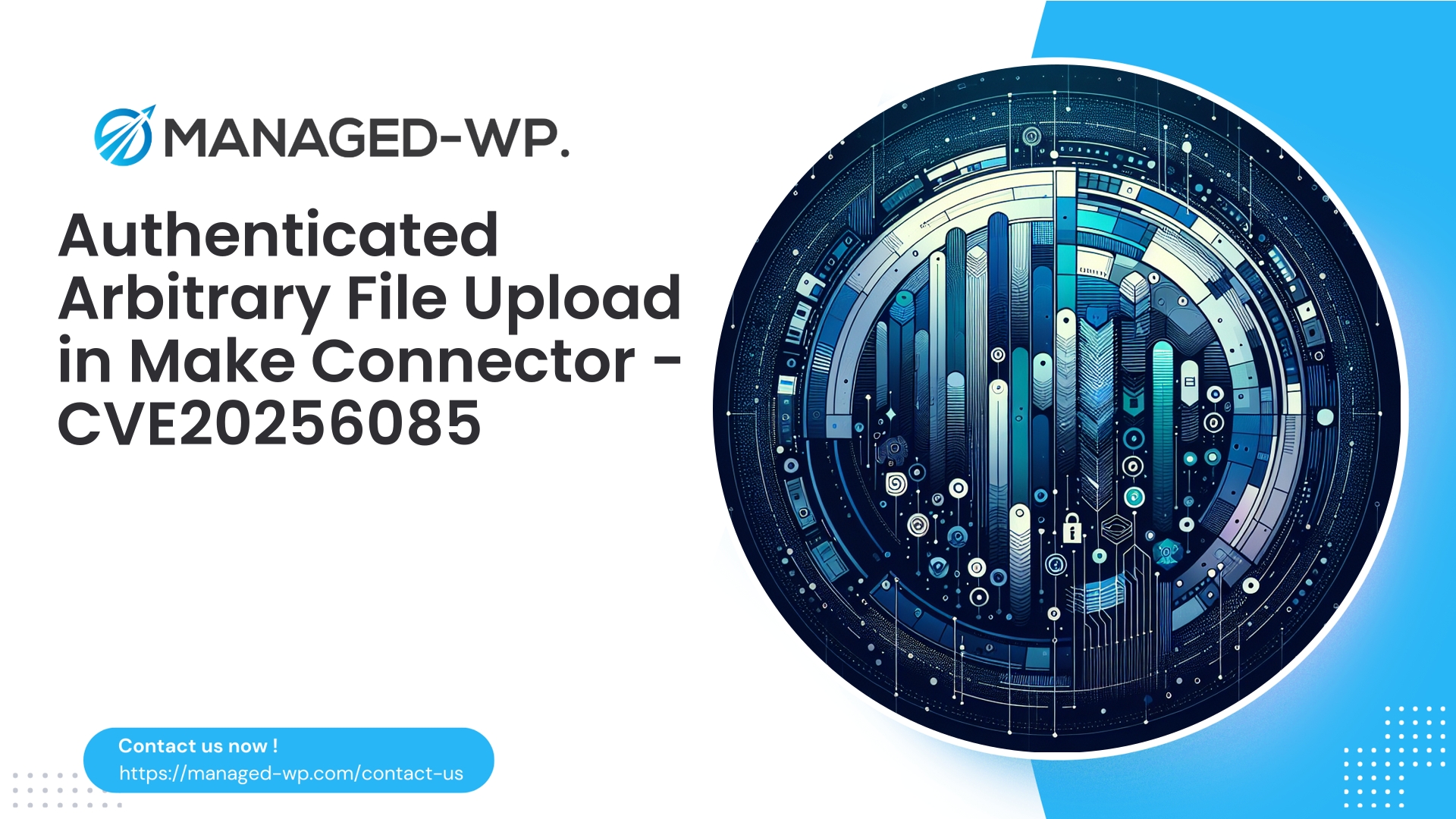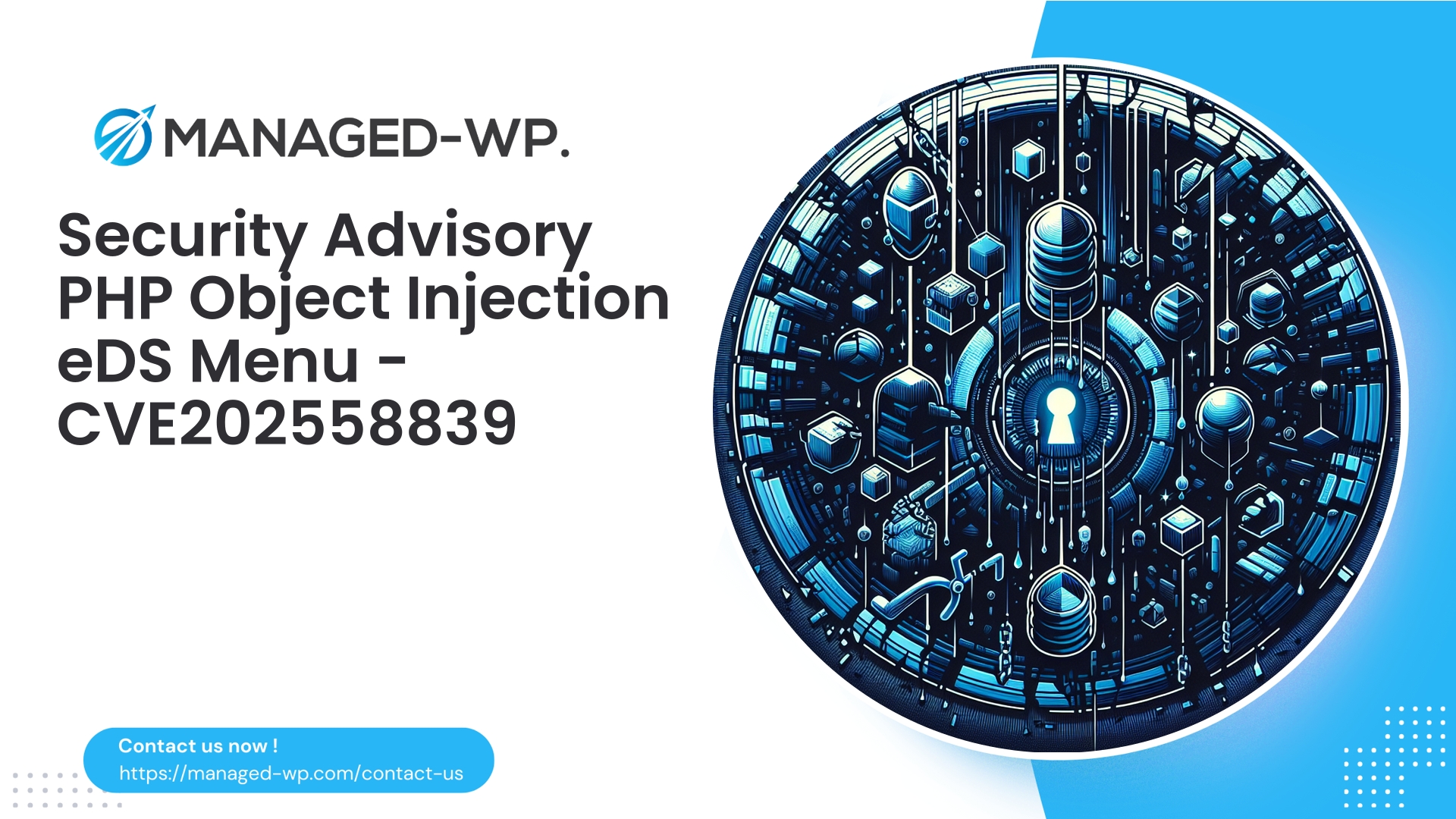| 插件名稱 | atec 偵錯 |
|---|---|
| 漏洞類型 | 已驗證的檔案刪除 |
| CVE編號 | CVE-2025-9518 |
| 緊急 | 低的 |
| CVE 發布日期 | 2025-09-03 |
| 來源網址 | CVE-2025-9518 |
atec Debug <= 1.2.22 — 已認證的任意檔案刪除漏洞 (CVE-2025-9518):網站管理員的即時指南
針對影響 atec Debug WordPress 外掛程式(版本最高至 1.2.22)的已認證任意檔案刪除漏洞,提供詳細的技術分析、風險評估、偵測方法和補救建議。
作者: 託管 WordPress 安全團隊
發布日期: 2025-09-04
標籤: WordPress、安全漏洞、atec Debug、CVE-2025-9518、Web 應用程式防火牆、安全加固
執行摘要
編號為 CVE-2025-9518 的安全漏洞影響 atec Debug WordPress 外掛程式的 1.2.22 及更早版本。該漏洞允許任何擁有管理員權限的已認證使用者透過插件暴露的功能刪除伺服器上的任意檔案。強烈建議用戶立即升級至 1.2.23 版本以降低風險。
雖然此漏洞利用需要攻擊者擁有管理員等級的存取權限,但此類憑證可以透過網路釣魚攻擊、憑證外洩或先前存在的漏洞取得。隨意刪除文件的能力會帶來重大風險,包括網站宕機、證據銷毀以及為後續攻擊提供便利。
本文全面分析了該漏洞,包括潛在利用跡象、事件回應建議和預防措施。託管型 Web 應用程式用戶端應專注於 Web 應用防火牆 (WAF) 和虛擬修補程式部分,以便採取實際有效的防護措施。
哪些人面臨風險?
- 運行atec Debug外掛程式版本1.2.22或更早版本的網站。
- 利用此漏洞需要具有管理員等級權限的已認證使用者。
- 外掛程式已透過網頁啟用或在子網站上啟用的多站點 WordPress 安裝。
- 即使網站認為其管理員的安全沒有受到威脅,也不應認為自己可以免受攻擊;憑證盜竊是一種常見的威脅途徑。
建議的解決方法: 升級到 atec Debug 1.2.23 盡快地。
技術分析:根本原因概述
這種漏洞源自於一個經典但至關重要的安全設計缺陷:
- 該插件提供了一個管理介面,允許刪除調試檔案或日誌檔案。
- 此刪除功能直接接受使用者輸入的檔案路徑或名稱,而沒有充分的驗證。
- 輸入資料將傳遞給 PHP 檔案刪除函數(例如)。
取消連結())而不驗證文件路徑的完整性或安全性。 - 沒有用處
真實路徑()或任何能有效限制刪除操作僅限於指定安全目錄的機制。 - 該插件在刪除端點上缺乏強大的 nonce 驗證或足夠的安全性令牌。
由此產生的影響: 經過身份驗證的管理員可以刪除關鍵文件,例如 ../../wp-config.php 或透過濫用嵌入在檔案路徑輸入中的目錄遍歷序列來修改外掛程式/主題核心檔案。
潛在後果包括:
- 由於缺少必要文件而導致網站不穩定或中斷。
- 銷毀法醫證據,例如日誌或植入後門,阻礙調查工作。
- 透過移除安全插件或備份文件,為更深層的入侵做好準備。
攻擊模式/概念驗證(概念性)
出於負責任的資訊揭露考慮,此處不會公佈特定的漏洞利用程式碼。但該攻擊利用已認證的 HTTP 請求,透過提供惡意檔案路徑來濫用刪除端點。以下範例展示了該攻擊的一般模式。
注意:在監控或測試時,請將網域名稱和會話令牌替換為您環境的特定資訊。
# 範例概念驗證 curl 'https://example.com/wp-admin/admin-ajax.php' \ -H 'Cookie: wordpress_logged_in=...' \ --data 'action=atec_debug_delete&file=../../wp-config.php' \ --compresseded
或者,也可以透過 POST 請求傳送到管理頁面:
POST /wp-admin/admin.php?page=atec-debug-tools HTTP/1.1 Host: example.com Cookie: wordpress_logged_in=... Content-Type: application/x-www-form-urlencoded delete_file=/at../Amit-
主要特點:
- 文件路徑參數直接接受使用者輸入。
- 伺服器端刪除,不受目錄限制。
- 需要通過身份驗證的管理員會話。
如果您在日誌中發現類似的可疑請求,則需要立即展開調查。
為什麼「低緊急程度」評級具有誤導性
該漏洞已被公開標記為“低緊急程度”,部分原因是利用漏洞需要管理員權限。然而,這種評級低估了實際風險,因為:
- 管理員憑證經常遭到洩漏、分享或被釣魚。
- 特權使用者刪除檔案的影響可能很嚴重——網站崩潰、惡意掩蓋或導致進一步的攻擊。
如果您的網站符合以下條件,請將此補丁視為高優先補丁:
- 擁有多個管理員或具有管理員權限的承包商。
- 允許第三方開發者或供應商擁有管理權限。
- 管理員未強制執行多因素身份驗證。
- 託管關鍵服務,任何中斷都是不可接受的。
關鍵的緊急行動(1-2小時內)
- 將atec Debug插件升級到版本1.2.23。 這是最可靠的補救措施。
- 如果無法升級,請暫時停用該插件。 在多站點環境下,透過網路停用該功能來阻止易受攻擊的端點。
- 限制管理員存取權限。 盡可能限制管理員按 IP 位址登錄,並強制使用強密碼和多因素身份驗證。
- 輪換所有管理員憑據。 變更所有管理員帳戶及相關服務帳戶的密碼。透過重置金鑰或強制註銷來註銷所有當前會話。
- 執行完整備份。 立即對檔案系統和資料庫進行快照,以便進行復原和取證調查。
- 審計管理活動。 查看近期使用者建立/修改記錄和稽核日誌,以發現可疑行為。
- 檢查是否有缺失或被篡改的關鍵文件。 檢查 WordPress 核心檔案、外掛程式和主題是否有意外刪除或變更。
事件回應和取證
如果您懷疑有剝削行為,請立即採取以下步驟:
- 保留所有日誌和證據—不要覆蓋或刪除任何檔案或日誌。
- 收集 Web 伺服器、PHP 和插件日誌以進行分析。
- 如果您的網站發生故障,請先打補丁,然後從經過驗證的乾淨備份中恢復。
- 恢復後輪換所有系統和資料庫密碼、API 金鑰和憑證。
- 從官方管道重新安裝所有安全插件並驗證其完整性。
- 執行全面的惡意軟體掃描,並檢查是否有 Web Shell 或異常的排程任務。
- 如果有更廣泛的妥協跡象,請立即聯繫專業緊急應變人員。
偵測與搜尋策略
請關注以下指標:
- 包含可疑參數的管理員端點請求,例如
文件=或者刪除文件=使用目錄遍歷序列(../). - 與管理員請求相關的無法解釋的 403、404 或 500 錯誤。
- 核心資料夾、外掛程式資料夾或主題資料夾中缺少檔案。
- 網站突然宕機或後台頁面損壞。
- 檔案時間戳發生意外變更或校驗和不符。
Linux shell 命令範例:
grep -i "admin-ajax.php" /var/log/nginx/access.log* | grep -E "file=|delete_file=" grep -R "\.\./" /var/log/nginx/access.log* /var/log/apache2/access.log* test -fhtml/var/log/apache2/access.log* test -fhtml/var/log/apache2/access.log* test -fhtml /
設定檔案完整性監控和 SIEM 規則,以擷取具有可疑有效負載的 admin-ajax POST 請求。
加固建議
- 遵循最小特權原則。 僅在必要時才分配管理員權限;其他情況下優先選擇編輯或作者角色。
- 使用強身份驗證。 要求所有管理員帳號使用唯一密碼並強制執行多因素身份驗證。
- 保護管理員端點。 限制存取權限
/wp-admin/和/wp-login.php按IP位址分類(如適用)。 - 停用透過控制面板進行文件編輯。 添加
定義('DISALLOW_FILE_EDIT',true);到wp-config.php. - 保持所有內容自動更新。 首先在測試/預發布環境中啟用 WordPress 核心、外掛和主題的自動更新。
- 實施Web應用程式防火牆(WAF)。 部署 WAF 規則以阻止可疑的管理員請求和目錄遍歷模式。
- 制定並執行安全的備份策略。 使用異地版本化備份,並定期驗證復原程序。
- 選擇高品質的插件。 使用積極維護和支援的插件;移除老舊或不使用的插件。
- 確保代碼級驗證。 外掛程式開發者應將允許的檔案名稱列入白名單,並將刪除操作限制在特定目錄中,並進行適當的輸入清理和隨機數檢查。
臨時虛擬補丁和WAF規則建議
對於無法立即升級外掛程式的環境,請考慮部署 WAF 或防火牆規則來緩解攻擊:
- 阻止任何帶有檔案參數名稱的請求(
文件=,刪除文件=等等)包含目錄遍歷序列,例如../或編碼後的等效物。 - 拒絕向 admin-ajax.php 或 admin.php 發送的試圖刪除關鍵 PHP 檔案的 POST 請求,例如
wp-config.php. - 對刪除端點的請求強制執行嚴格的參考驗證或要求有效的 nonce/令牌。
- 限制 admin-ajax.php 的訪問次數,以防止暴力破解或自動化攻擊。
筆記: 徹底測試這些規則,以最大限度地減少誤報,避免干擾合法的行政操作。
mod_security 規則範例(範例)
SecRule REQUEST_URI "@beginsWith /wp-admin/admin-ajax.php" \ "phase:2,chain,deny,status:403,log,msg:'阻止透過路徑遍歷進行任意檔案刪除'" SecRule ARGS_NAMES|ARGS "(Vnamei) \Vdeleteetefile" "(?:\.\./|\.\.\\||)"
此規則阻止對 admin-ajax.php 的請求,其中輸入參數疑似用於檔案刪除,且包含目錄遍歷序列。
補救後步驟
- 請確認插件已更新至 1.2.23 版本,如不需要則刪除。
- 從乾淨的備份中還原任何遺失或更改的關鍵檔案。
- 重新執行惡意軟體和檔案完整性掃描,以確保網站安全。
- 輪換所有敏感密碼和安全密鑰。
- 審核並限制管理員存取權限;啟用強制多因素身份驗證。
- 實施WAF規則以防止未來出現類似的攻擊。
- 記錄經驗教訓並更新事件回應程式。
- 如果懷疑有資料外洩或持久性後門,請立即聯絡專業安全響應人員。
管理員推薦的監控查詢
- 搜尋 Web 伺服器日誌,尋找 admin-ajax 或 admin.php 請求中的可疑參數:
grep -i "admin-ajax.php" /var/log/*access* | grep -i "admin-ajax.php" /var/log/*access* | grep -E "檔案=|delete_file=|檔案路徑="
- 識別來自異常 IP 位址的登入資訊:
grep "wp-login.php" /var/log/*access* | grep "wp-login.php" /var/log/*access* | awk '{print $1}' |排序| uniq-c|排序-nr
- 在 WordPress 目錄中尋找最近修改或刪除的檔案:
尋找 /var/www/html -type f -mtime -7 -ls
- 檢查 WordPress 管理員使用者表是否有異常條目:
SELECT ID, user_login, user_email, user_registered FROM wp_users; SELECT user_id, meta_value FROM wp_usermeta WHERE meta_key = 'wp_capabilities';
為什麼這種漏洞需要被重視
許多網站所有者低估了需要身份驗證才能存取的漏洞所帶來的風險。然而,管理員帳號被盜用卻是一種非常常見的攻擊途徑。一旦攻擊者獲得管理員憑證(透過網路釣魚、重複使用密碼或其他漏洞),諸如任意檔案刪除之類的漏洞就會被利用,造成最大程度的破壞。
攻擊者可以利用此功能:
- 刪除備份和日誌文件,抹去痕跡。
- 在安裝惡意程式碼或Web Shell之前,請先移除安全性插件。
- 造成系統中斷或損害網站聲譽。
管理員必須透過限制權限和嚴格保護存取權限來最大限度地減少這種攻擊面。
插件開發者和維護者的指南
- 切勿在未進行全面驗證的情況下,根據使用者輸入執行文件操作。
- 使用
真實路徑()檢查以確保路徑始終位於允許的目錄內。 - 執行嚴格的能力檢查(例如,
current_user_can('manage_options'))以及對所有破壞性操作進行 nonce 驗證。 - 只允許刪除白名單中的檔案名,或對刪除操作施加目錄限制。
- 記錄所有管理文件刪除操作,並提供足夠的稽核細節。
強大的託管安全功能,配備 Managed-WP
Managed-WP 提供針對 WordPress 網站的即時、強大的保護。我們的免費方案提供針對身份驗證後威脅的基礎防禦,並透過以下方式加速威脅偵測:
- 針對 WordPress 專門最佳化的託管 Web 應用程式防火牆規則。
- 無限頻寬和自動阻止常見攻擊途徑,包括路徑遍歷和可疑的管理員請求。
- 整合惡意軟體掃描和緩解功能,符合 OWASP 十大風險優先順序。
立即開始使用我們的免費保護方案! https://my.wp-firewall.com/buy/wp-firewall-free-plan/
對於管理多個站點的組織,我們的高級計劃包括自動惡意軟體清除、IP 黑名單、每月安全報告以及針對新出現的漏洞的及時虛擬修補。
摘要及建議措施
- 請確認您的網站是否使用atec Debug 版本1.2.22或更早版本。
- 請立即更新至 1.2.23 版本。如果無法更新,請暫時停用該插件。
- 對所有管理員帳戶啟用多重身份驗證並輪換憑證。
- 審核管理日誌,尋找可疑的刪除要求,並驗證檔案完整性。
- 部署 WAF 規則,阻止包含檔案參數中目錄遍歷的請求。
- 維護經過測試的異地備份,以便快速復原。
Managed-WP 安全團隊的最後總結
這個漏洞凸顯了 WordPress 安全性中一個反覆出現的問題:管理功能可能基於未經驗證的使用者輸入執行操作。雖然程式碼層面的修復很簡單(實施全面的驗證、白名單和 nonce 保護),但網站所有者面臨的實際操作風險仍然很大。
網站安全取決於及時打補丁、精心管理、多層防護以及持續監控。無論您經營的是單一網站還是多個 WordPress 網站,採用 Managed-WP 等託管式安全防護方案(例如防火牆和惡意軟體掃描)都能提供關鍵的安全基線,並為您爭取寶貴的修復時間。
立即審核您的管理員帳戶並立即套用建議的更新,以保護您的網站。











